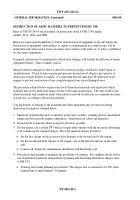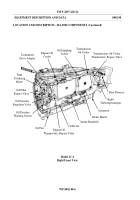TM-9-2815-220-24 - Page 36 of 1563
TM 9-2815-220-24
GENERAL INFORMATION (Continued)
0001 00
DESTRUCTION OF ARMY MATERIEL TO PREVENT ENEMY USE
Refer to TM 750-244-6 for procedures on destruction of the AVDS-1790 engine,
models -2CA, -2DA, and-2DR
Below are some general guidelines to follow in destruction of equipment to prevent enemy use.
Destruction of equipment, when subject to capture or abandonment in a combat zone, will be
undertaken only when such action is necessary in accordance with orders of, or policy established
by, the Army commander.
In general, destruction of essential parts, followed by burning, will usually be sufficient to render
equipment useless.
Time is usually critical.
Materiel must be damaged so that it cannot be restored to usable condition by either repair or
cannibalization.
If lack of time or personnel prevents destruction of all parts, give priority to
destruction of parts hardest to replace.
It is important that the same parts be destroyed on all
engines to prevent construction of one complete engine from several damaged ones.
The procedure outlined below requires the use of demolition materials and explosives which
normally may not be authorized items of issue to the using organization.
The issue of these and
related materials and conditions under which destruction will be effected, are command decisions
in each case, according to the tactical situation.
Varying degrees of damage to the armament and other equipment may be expected during
destruction of engine as outlined below:
1. Smash all vital elements such as auxiliary power unit, switches, coupling devices, mechanical
pumps and all accessible engine components. Slash electrical cables and harnesses.
2. Drain fuel oil or puncture them as near the bottom as possible.
3. For the engine, use 1-pound TNT blocks or equivalent together with the necessary detonating
cord to make up the required charges.
Place the required charges as follows:
•
Set the first charge on the accessory drive housing at the forward end of the engine.
•
Set the second and third charges on the engine, one on the left side and one on the right
side.
•
Connect all charges for simultaneous detonation with detonating cord.
4. Provide for dual priming to minimize the possibility of a misfire.
For complete details on the
use of demolition materials and methods of priming and detonating demolition charges, refer
to FM 5-25.
•
Training and careful planning are essential.
The danger area is estimated to be 500 yards;
elapsed time is approximately 10 minutes.
WP 0001 00-2
Back to Top




















